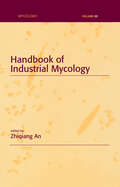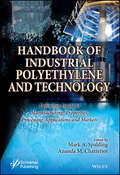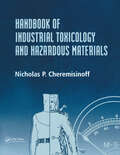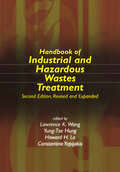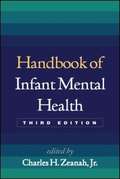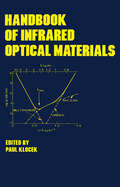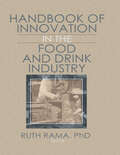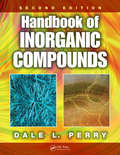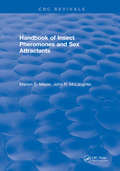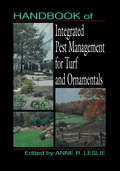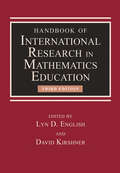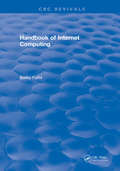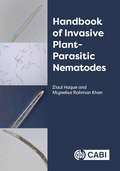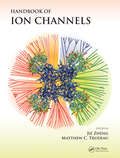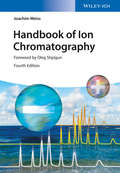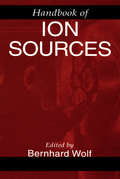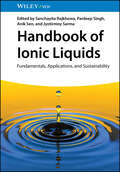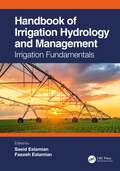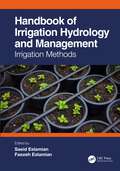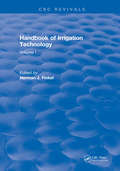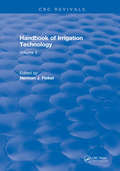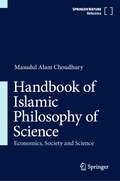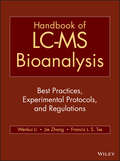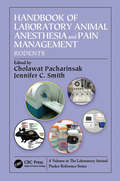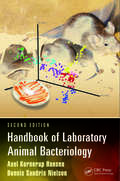- Table View
- List View
Handbook of Industrial Mycology (Mycology Ser. #Vol. 22)
by Zhiqiang AnSeveral excellent books have been published that address one or more aspects of the diverse field of industrial mycology, but none of them cover the entire process of fungal bioactive metabolites discovery. Until now. The Handbook of Industrial Mycology provides, in one volume, an overview of recent developments in industrial mycology with emphasis
Handbook of Industrial Polyethylene and Technology: Definitive Guide to Manufacturing, Properties, Processing, Applications and Markets
by Mark A. Spalding Ananda ChatterjeeThis handbook provides an exhaustive description of polyethylene. The 50+ chapters are written by some of the most experienced and prominent authors in the field, providing a truly unique view of polyethylene. The book starts with a historical discussion on how low density polyethylene was discovered and how it provided unique opportunities in the early days. New catalysts are presented and show how they created an expansion in available products including linear low density polyethylene, high density polyethylene, copolymers, and polyethylene produced from metallocene catalysts. With these different catalysts systems a wide range of structures are possible with an equally wide range of physical properties. Numerous types of additives are presented that include additives for the protection of the resin from the environment and processing, fillers, processing aids, anti-fogging agents, pigments, and flame retardants. Common processing methods including extrusion, blown film, cast film, injection molding, and thermoforming are presented along with some of the more specialized processing techniques such as rotational molding, fiber processing, pipe extrusion, reactive extrusion, wire and cable, and foaming processes. The business of polyethylene including markets, world capacity, and future prospects are detailed. This handbook provides the most current and complete technology assessments and business practices for polyethylene resins.
Handbook of Industrial Toxicology and Hazardous Materials
by Nicholas P. CheremisinoffProviding vital safety information on over 1000 commerical chemicals, this work explores up-to-date data on fire and chemical compatibility, response methods for incidents involving chemical spills and fires, and personnel and worksite safety monitoring and sampling. The book includes more than 700 illustrations, structures, equations and tables, and a glossary with over 700 definitions.
Handbook of Industrial and Hazardous Wastes Treatment (Advances in Industrial and Hazardous Wastes Treatment)
by Lawrence K. Wang Yung-Tse Hung Howard H. Lo Constantine YapijakisPresenting effective, practicable strategies modeled from ultramodern technologies and framed by the critical insights of 78 field experts, this vastly expanded Second Edition offers 32 chapters of industry- and waste-specific analyses and treatment methods for industrial and hazardous waste materials-from explosive wastes to landfill leachate to w
Handbook of Infant Mental Health
by Charles H. ZeanahWidely regarded as the standard reference in the field, this state-of-the-art Handbook offers a comprehensive analysis of developmental, clinical, and social aspects of mental health from birth to the preschool years. Leading authorities explore models of development; biological, family, and sociocultural risk and protective factors; and frequently encountered disorders and disabilities. Evidence-based approaches to assessment and treatment are presented, with an emphasis on ways to support strong parent-child relationships. The volume reviews the well-documented benefits of early intervention and prevention and describes applications in mental health, primary care, childcare, and child welfare settings. The chapter on psychopharmacology has been updated for the paperback edition.
Handbook of Infrared Optical Materials (Optical Science and Engineering #Vol. 30)
by Paul KlocekThis book includes a comprehensive presentation of the fundamental physics of optical matter, the definition of material physical properties, the listing and comparison of the physical properties of infrared optical materials, and the theory, design, and survey of infrared optical coatings.
Handbook of Innovation in the Food and Drink Industry
by Ruth RamaFilled with extensive reviews, The Handbook of Innovation in the Food and Drink Industry goes beyond the traditional perspectives to explore neglected aspects of technological change in this industry. Leading international specialists discuss economic and managerial aspects of innovation, technological change, new product introduction, and research and development. They examine food quality and society, dynamic innovations, the role of biotechnology, and future challenges in the industry in detail. Providing a well-rounded view the entire industry and where it is heading, the book includes study cases, analyses of large databases and other tools, economic analyses, and crucial survey results.
Handbook of Inorganic Compounds
by Dale L. PerryFor anyone that needs property data for compounds, CASRN numbers for computer or other searches, a consistent tabulation of molecular weights to synthesize inorganic materials on a laboratory scale, or information on commercial and other uses for various compounds, this volume is the perfect reference. This second edition is fully revised and updated. New data include optical inorganics, radiation detection inorganics, thermochromic compounds, piezochromic compounds, metal ion coordination complexes, expanded crystallographic and structural data for inorganics, catalysts, superconductors, and luminescent (fluorescent and phosphorescent) inorganics.
Handbook of Insect Pheromones and Sex Attractants
by Marion S. MayerThis book focuses on chemicals that effect aggregation for mating and elicit sexual behavior in insects, mites, and ticks, mainly on "sex pheromonal" or "mating" activity. These pheromones are useful to both agriculture science and industry because of their potential as detection and control agents.
Handbook of Integrated Pest Management for Turf and Ornamentals
by Anne R. LeslieThis essential reference provides complete coverage of integrated pest management (IPM). With more than 40 recognized experts, the book thoroughly details the rationale and benefits of employing an IPM plan and provides technical information on each aspect from cultural practices to choosing when and how to use chemicals. It also brings together research work on pest problems with information on the practical implementation of the tools. Case studies of successful operations are provided as well.
Handbook of International Research in Mathematics Education (100 Cases Ser.)
by Lyn D. English David KirshnerThis third edition of the Handbook of International Research in Mathematics Education provides a comprehensive overview of the most recent theoretical and practical developments in the field of mathematics education. Authored by an array of internationally recognized scholars and edited by Lyn English and David Kirshner, this collection brings together overviews and advances in mathematics education research spanning established and emerging topics, diverse workplace and school environments, and globally representative research priorities. New perspectives are presented on a range of critical topics including embodied learning, the theory-practice divide, new developments in the early years, educating future mathematics education professors, problem solving in a 21st century curriculum, culture and mathematics learning, complex systems, critical analysis of design-based research, multimodal technologies, and e-textbooks. Comprised of 12 revised and 17 new chapters, this edition extends the Handbook’s original themes for international research in mathematics education and remains in the process a definitive resource for the field.
Handbook of Internet Computing (Internet And Communications Ser. #5)
by Borko FurhtScientists in different geographical locations conduct real-time experiments in a virtual shared workspace. E-commerce provides an emerging market for businesses large and small. E-mail, Servers, and Enterprise Resources Planning have revolutionized businesses on every level. People from all over the globe gather in chat rooms. The Internet is here to stay and Internet technologies and applications continue to grow and evolve.The Handbook of Internet Computing presents comprehensive coverage of all technical issues related to the Internet and its applications. It addresses hot topics such as Internet architectures, content-based multimedia retrieval on the Internet, Web-based collaboration, Web search engines, digital libraries, and more. Real-life examples illustrate the concepts so that technical, non-technical and business people can quickly grasp the fundamentals.
Handbook of Invasive Plant-parasitic Nematodes
by Dr Ziaul Haque Dr Mujeebur Rahman KhanPlant parasitic nematodes are major pests of agricultural crops and cause huge monetary losses. There is a very high risk of spread of plant-parasitic nematodes from one country to another, with the movement of plants and planting materials such as seeds, bulbs, corms, suckers, tubers, rhizomes, rooted plants, nursery stock and cut flowers. In view of the large quantities and the wide variety of materials being imported and exported, it is important to assess the status of invasive nematodes and their quarantine importance in relation to agricultural trade. This book contains information on around 100 invasive nematodes and their potential threat in different countries. Each nematode entry includes information on authentic identification, geographical distribution, risk of introduction, host ranges, symptoms, biology, ecology, planting material liable to carry the nematode(s), nematode vectors, chance of establishment, likely impact, and phytosanitary measures. There are detailed accounts of diagnosis procedures including sampling, isolation, detection and identification of nematodes based on morphological and molecular characters. The book offers a global perspective on invasive plant-parasitic nematodes and useful for practitioners, professionals, scientists, researchers, students, and government officials working in plant quarantine and biosecurity.
Handbook of Ion Channels
by Jie Zheng Matthew C. TrudeauThe New Benchmark for Understanding the Latest Developments of Ion ChannelsIon channels control the electrical properties of neurons and cardiac cells, mediate the detection and response to sensory stimuli, and regulate the response to physical stimuli. They can often interact with the cellular environment due to their location at the surface of ce
Handbook of Ion Chromatography 3 Volume Set
by Joachim Weis Oleg ShpigunAuthored by the true pioneer of this method, this two-volume handbook is the standard reference in the field, unparalleled in its comprehensiveness. As such, it covers every conceivable topic related to the expanding and increasingly important field of ion chromatography. This fourth edition is completely updated and revised to include the latest developments in the instrumentation, with Volume 2 completely rewritten to reflect the current state of applications. Approximately 30% new material.
Handbook of Ion Sources
by Bernhard WolfThe Handbook of Ion Sources delivers the data needed for daily work with ion sources. It also gives information for the selection of a suitable ion source and ion production method for a specific application.The Handbook concentrates on practical aspects and introduces the principle function of ion sources. The basic plasma parameters are defined and discussed. The working principles of various ion sources are explained, and examples of each type of ion source are presented with their operational data. Tables of ion current for various elements and charge states summarize the performance of different ion sources.The problems related to the production of ions of non-gaseous elements are detailed, and data on useful materials for evaporation and ion source construction are summarized. Additional chapters are dedicated to extraction and beam formation, ion beam diagnosis, ion source electronics, and computer codes for extraction, acceleration, and beam transport. Emittance and brilliance are described and space charge effects and neutralization discussed. Various methods for the measurement of current, profile, emittance, and time structure are presented and compared. Intensity limits for these methods are provided for different ion energies.Typical problems related to the operation of ion source plasmas are discussed and practical examples of circuits are given. The influence of high voltage on ion source electronics and possibilities for circuit protection are covered. The generation of microwaves and various microwave equipment are described and special problems related to microwave operation are summarized.The Handbook of Ion Sources is a valuable reference on the subject, of benefit to practitioners and graduate students interested in accelerators, ion implantation, and ion beam techniques.
Handbook of Ionic Liquids: Fundamentals, Applications and Sustainability
by Pardeep Singh Sanchayita Rajkhowa Anik Sen Jyotirmoy SarmaHandbook of Ionic Liquids A one-stop reference for researchers interested in ionic liquids and their applications Handbook of Ionic Liquids: Fundamentals, Applications, and Sustainability, constitutes an overview of the latest advances in ionic liquid chemistry. It offers a comprehensive summary of the development history of ionic liquids, their design, and the diverse array of applications—including green and sustainable synthesis, catalysis, drug development and medicine, biotechnology, materials science, and electrochemistry. The authors explain a variety of processes used to develop novel materials with ionic liquids and describe likely future developments using practical examples taken from contemporary research and development in the field. The book includes discussions of biomass conversion, CO2 capture, and more. You’ll also discover: A thorough introduction to the theory of ionic liquids, as well as their different types and recycling methods Comprehensive explorations of the physico-chemical properties of ionic liquids Practical discussions of ionic liquid synthesis and analysis, including green synthesis and heterocyclic chemistry applications Summary of the use of ionic liquids in materials science, including polymers, energy conversion, and storage devices Perfect for organic, catalytic, physical, analytical, and environmental chemists, Handbook of Ionic Liquids: Fundamentals, Applications, and Sustainability will also benefit electrochemists, materials scientists, and biotechnologists with an interest in ionic liquids and their application.
Handbook of Irrigation Hydrology and Management: Irrigation Fundamentals
by Saeid Eslamian Faezeh EslamianEver-increasing population growth has caused a proportional increased demand for water, and existing water sources are depleting day by day. Moreover, with the impact of climate change, the rates of rainfall in many regions have experienced a higher degree of variability. In many cities, government utilities have been struggling to maintain sufficient water for the residents and other users. The Handbook of Irrigation Hydrology and Management examines and analyzes irrigated ecosystems in which water storage, applications, or drainage volumes are artificially controlled in the landscape and the spatial domain of processes varies from micrometers to tens of kilometers, while the temporal domain spans from seconds to centuries. The continuum science of irrigation hydrology includes the surface, subsurface (unsaturated and groundwater systems), atmospheric, and plant subsystems. Further, the book includes coverage of environmental and economic impacts, water quality issues, water harvesting, satellite measurements for irrigation, and more. Features: Offers water-saving strategies to increase the judicious use of scarce water resources Presents strategies to maximize agricultural yield per unit of water used for different regions Compares irrigation methods to offset changing weather patterns and impacts of climate change
Handbook of Irrigation Hydrology and Management: Irrigation Methods
by Saeid Eslamian Faezeh EslamianEver-increasing population growth has caused a proportional increased demand for water, and existing water sources are depleting day by day. Moreover, with the impact of climate change, the rates of rainfall in many regions have experienced a higher degree of variability. In many cities, government utilities have been struggling to maintain sufficient water for the residents and other users. The Handbook of Irrigation Hydrology and Management: Irrigation Methods examines and analyzes irrigated ecosystems in which water storage, applications, or drainage volumes are artificially controlled in the landscape and the spatial domain of processes varies from micrometers to tens of kilometers, while the temporal domain spans from seconds to centuries. The continuum science of irrigation hydrology includes the surface, subsurface (unsaturated and groundwater systems), atmospheric, and plant subsystems. Further, the book addresses the best practices for various types of irrigation methods including pressure, smart, surface, and subsurface, and presents solutions for water scarcity and soil salinity in irrigation.Features: Offers water-saving strategies to increase the judicious use of scarce water resources Presents strategies to maximize agricultural yield per unit of water used for different regions Compares irrigation methods to offset changing weather patterns and impacts of climate change
Handbook of Irrigation Technology: Volume 1
by Herman J. FinkelThis title was first published in 1982: Overview of Irrigation
Handbook of Irrigation Technology: Volume 2
by herman J. FinkelThis book was first published in 1983. It provides a comprehensive overview of irrigation technologies, techniques and economics, tailored to a multitude of different crops.
Handbook of Islamic Philosophy of Science: Economics, Society and Science
by Masudul Alam ChoudhuryThis handbook provides a comprehensive overview of Islamic ethical issues within a wide spectrum of philosophy of science topics, examining the development of the model of moral inclusiveness in economics, science and society from ontological, epistemological and analytical perspectives. This paradigm takes the view that ethics is systemically endogenous, and can be studied by the most rigorous scientific analysis pertaining to diverse issues and problems of ethicality in socio-scientific inquiry. This handbook takes a sweeping transdisciplinary approach that is deeply phenomenological, to the nature and logic of scientific inquiry of, and in, the Qur’an. Such an approach invokes the episteme of the unity of knowledge in the socio-scientific systemic sense. The volumes' respective sections focus on the nature, logic, and role that ethics plays in formulating new vistas of alternative epistemic futures in Islamic economics, finance, and the social sciences. The ideas presented are situated within the broader context of the post-modernist, post-pandemic, and the post-Covid-19 epoch, while being aimed at conceptualising a distinctive new outlook of transdisciplinary intellection in Islamic philosophy. The content is rigorously conceptual, qualitative, quantitative, and applied. Covering a diversity of subject areas from philosophy of science, to economics and in socio-scientific context within the realm of Islamic philosophy, this forms a key text for scholars in these respective arenas, led by pioneering scholarship in Islamic studies.
Handbook of LC-MS Bioanalysis
by Francis L. Tse Jie Zhang Wenkui LiConsolidates the information LC-MS bioanalytical scientists need to analyze small molecules and macromoleculesThe field of bioanalysis has advanced rapidly, propelled by new approaches for developing bioanalytical methods, new liquid chromatographic (LC) techniques, and new mass spectrometric (MS) instruments. Moreover, there are a host of guidelines and regulations designed to ensure the quality of bioanalytical results.Presenting the best practices, experimental protocols, and the latest understanding of regulations, this book offers a comprehensive review of LC-MS bioanalysis of small molecules and macromolecules. It not only addresses the needs of bioanalytical scientists working on routine projects, but also explores advanced and emerging technologies such as high-resolution mass spectrometry and dried blood spot microsampling.Handbook of LC-MS Bioanalysis features contributions from an international team of leading bioanalytical scientists. Their contributions reflect a review of the latest findings, practices, and regulations as well as their own firsthand analytical laboratory experience. The book thoroughly examines:Fundamentals of LC-MS bioanalysis in drug discovery, drug development, and therapeutic drug monitoringThe current understanding of regulations governing LC-MS bioanalysisBest practices and detailed technical instructions for LC-MS bioanalysis method development, validation, and stability assessment of analyte(s) of interestExperimental guidelines and protocols for quantitative LC-MS bioanalysis of challenging molecules, including pro-drugs, acyl glucuronides, N-oxides, reactive compounds, and photosensitive and autooxidative compoundsWith its focus on current bioanalytical practice, Handbook of LC-MS Bioanalysis enables bioanalytical scientists to develop and validate robust LC-MS assay methods, all in compliance with current regulations and standards.
Handbook of Laboratory Animal Anesthesia and Pain Management: Rodents (Laboratory Animal Pocket Reference)
by Cholawat Pacharinsak Jennifer C. SmithKey features: Presents practical information in easily accessible ‘bullet point’ format Covers anesthetic machine and related equipment, anesthetic management and monitoring, anesthesia and analgesia pharmacology, euthanasia, and record keeping Written by well-recognized experts in the laboratory animal community Provides extensive references to direct the reader to sources for further study of alternative techniques and their procedures Concludes with a thorough chapter on Regulatory Management of Rodent Anesthesia which has global application Rodents are the most commonly used species in biomedical research. Individuals conducting rodent research are often responsible to ensure that all areas of anesthesia and analgesia are performed humanely. Anesthetic agent selection, anesthetic monitoring, and postoperative pain assessment and management are essential to the institutional animal care and use program and contribute significantly to the 3Rs by reducing pain and/or distress and refining various procedures. The Handbook of Laboratory Animal Anesthesia and Pain Management: Rodents is the first book to capture multiple advances in this important area that greatly impacts various experimental methodologies. Richly illustrated in full color, the book serves as a quick reference source for investigators, veterinarians, technicians, and other animal caretakers charged with the care and use of rodents in a research setting. The unique format of this book also makes it extremely valuable to IACUC members, institutional officials, and occupational health and safety professionals.
Handbook of Laboratory Animal Bacteriology
by Axel Kornerup Hansen Dennis Sandris NielsenThe Handbook of Laboratory Animal Bacteriology, Second Edition provides comprehensive information on all bacterial phylae found in laboratory rodents and rabbits to assist managers, veterinary pathologists and laboratory animal veterinarians in the management of these organisms. The book starts by examining the general aspects of bacteriology and h
